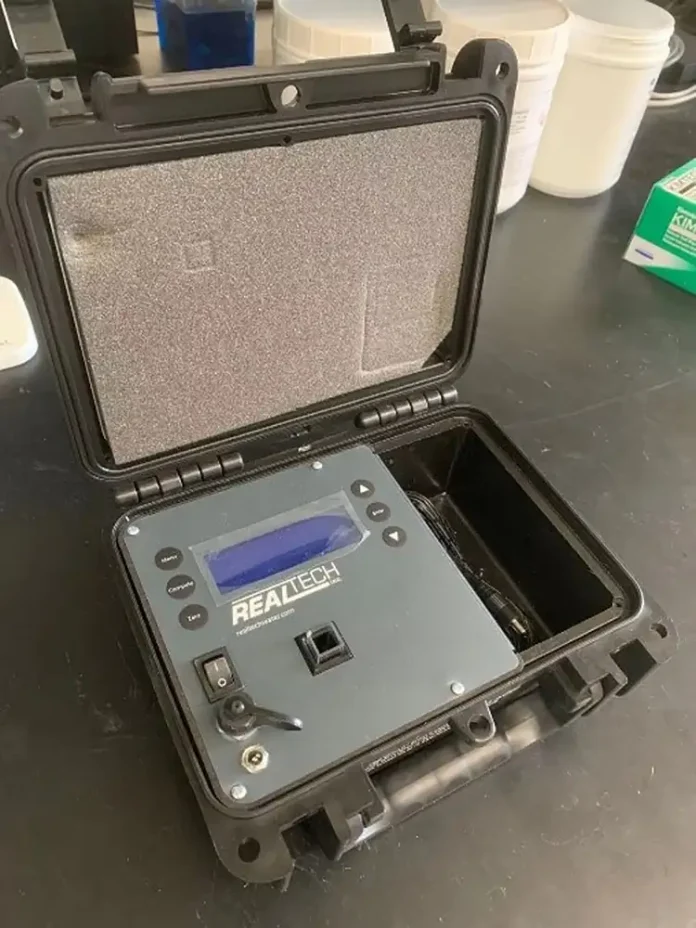Liz Stevens, writer, UV Solutions
A collaboration among Dr. Chengjin Wang of the University of Manitoba, Professor Ronald Hofmann of the University of Toronto, and Erik Rosenfeldt of Hazen and Sawyer has resulted in the creation of a new method to measure the hydroxyl radical scavenging capacity of water awaiting treatment. This parameter can be used to inform the control and adjustment of water treatment via advanced oxidation processes (AOPs). Conventional methods for its measurement are time-consuming and require sophisticated instrumentation and expertise.
The three researchers have created a novel approach to measure this parameter using an external calibration process to conduct fast and robust measurements. The method now is being developed into a simple, portable monitoring device that will empower treatment plants to understand the variation of the scavenging capacity of water on a regular basis so that plants can adopt corresponding measures to adjust and optimize operations.
The method for measuring scavenging capacity uses low-pressure UV/H2O2 as the •OH generation system, methylene blue (MB) as the probe compound and isopropyl alcohol (IPA) as the standard. Other options, such as different dyes, oxidants and standards, are being explored.
By monitoring the color decay of MB in a series of IPA solutions with different known scavenging capacity, a calibration curve is established between the color decay rate and the scavenging capacity. The measured color decay in real water samples then can be used with this external calibration to estimate their scavenging capacity. Work was undertaken to ensure that the process would be robust under a wide range of water quality conditions.
“The core process in the device is a calibrated mini-AOP process,” Wang explained. “‘Calibrated’ means that the process has a fixed hydroxyl radical production rate, and the dye’s color decay rate, therefore, is inversely related to the scavenging capacity of the water.” The “mini” aspect of the process not only reflects the scale of the device, but also plays a critical role in determining whether the external calibration method works or not.
“Specifically, we want the water depth in our device to be small enough to keep the fluence rate (i.e., UV dose) independent of the water matrices,” said Wang. “Imagine this: When the water layer is thin, it does not absorb much light, and the average fluence rate is almost the same as that at the water surface. In this case, the average fluence rate is consistent among different water samples, making the calibration curve established in pure water matrix applicable to other matrices.” As the goal of this mini system is to determine the scavenging capacity, as opposed to simulating the full-scale AOP performance, the mini system was optimized to serve the measurement purpose. This results in different operating parameters (chemical doses, UV dose and light path length) in the mini system than what would be found in treatment plant reactors. The device uses low-pressure mercury UV lamps, emitting at 253.7 nm. Future research will include testing of UV LED lamps for a mercury-free, quick-start alternative.
Once the hydroxyl radical scavenging capacity of a water sample is determined, a treatment plant could optimize its AOP system by adjusting the UV dose and the hydrogen peroxide dose for optimal results. “For example, if the scavenging capacity increases,” said Wang, “the plant can increase the UV dose or chemical dose to increase the hydroxyl radical generation. If the scavenging capacity is way too high, our device can give the plant a warning that the desired micropollutant removal cannot be achieved until the scavenging capacity is decreased by some enhanced pretreatment before AOPs.” Wang noted that water treatment plants currently do not alter their UV dose and often operate at full UV capacity. This new method and device may change that, leading to potential cost savings and more robust operation.
The device specifically was designed as a cost-efficient portable measurement system for use in water treatment plants that do not need continuous online monitoring and for use in research laboratories. The device is suitable for use with any advanced oxidation processes that rely on hydroxyl radical as the main oxidant, including ozone/hydrogen peroxide and Fenton systems.
Wang and Hofmann are partnering with Real Tech Inc., Ontario, Canada, to develop a commercial device, with associated fundamental research on the chemical technique sponsored by the Natural Sciences and Engineering Research Council and the Water Research Foundation. R&D work is in progress to optimize the ease of use and robustness of the device, with commercial availability anticipated in the near future.
The inventors of this method and device earned a 2021 IUVA RadLaunch award for their external calibration method and portable monitoring device.
Additional information about the method can be found in “External Standard Calibration Method to Measure the Hydroxyl Radical Scavenging Capacity of Water Samples,” an Environmental Science & Technology article by Wang et al., at https://doi.org/10.1021/acs.est.9b06273. For more information, email Dr. Wang at Chengjin.Wang@umanitoba.ca.






